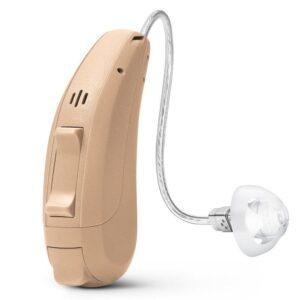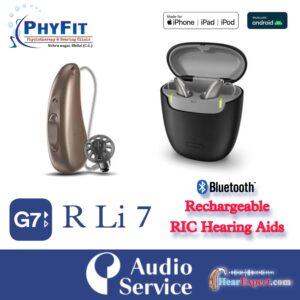Hearing loss affects millions worldwide, impacting communication, confidence, and overall quality of life. In recent years, hearing aid technology has made significant strides, offering more discreet, comfortable, and powerful solutions. Among the most notable advancements is the development of Receiver-in-Canal (RIC) hearing aids—a style that has quickly become a favorite among users and audiologists alike.
In this article, we’ll explore what RIC hearing aids are, how they work, and why they’re considered a game-changer in the world of hearing healthcare.
What Are RIC Hearing Aids?

Receiver-in-Canal (RIC) hearing aids, also known as Receiver-in-the-Ear (RITE) hearing aids, are a type of behind-the-ear (BTE) hearing aid. Unlike traditional BTE models, where the receiver (or speaker) is located within the main body of the hearing aid, RIC hearing aids place the receiver directly inside the ear canal. This design is made possible through a thin wire that connects the behind-the-ear component to the receiver.
The result? A sleek, nearly invisible hearing aid that delivers clearer, more natural sound.
Also Read: What Is a Receiver-In-Canal (RIC) Hearing Aid?
Key Components of a RIC Hearing Aid
Microphone: Picks up sound from the environment.
Amplifier: In the body of the device, processes the sound.
Receiver (Speaker): Placed in the ear canal, delivers sound directly.
Thin Wire: Connects the processor behind the ear to the receiver.
Dome or Custom Earmold: Sits inside the ear canal, holding the receiver in place.
This separation of components allows for a more compact and comfortable design with improved sound delivery.
Why RIC Hearing Aids Are a Game-Changer
1. Superior Sound Quality
Because the receiver is located inside the ear canal, RIC hearing aids deliver sound more directly and naturally. The proximity of the receiver to the eardrum reduces sound distortion and improves clarity, especially for high-frequency sounds. This is particularly beneficial for people with sensorineural hearing loss, which often affects the ability to hear high-pitched sounds like birds chirping or speech consonants.
Many RIC devices also come with advanced sound processing algorithms that adapt to different listening environments, automatically adjusting for noise, speech, and background sounds.
2. Discreet and Stylish Design
RIC hearing aids are among the most discreet styles available. The main body of the device sits behind the ear and is often small enough to be hidden by hair or glasses. The thin wire and receiver are nearly invisible, making RICs a great option for users who are concerned about the visibility of their hearing aids.
Today’s RIC models are also available in various colors and styles to match skin tone or personal preferences.
3. Comfort and Ease of Use
The separation of the receiver from the amplifier allows for a lighter and more comfortable fit. Because less of the ear is blocked compared to traditional BTE or in-the-ear (ITE) models, users often report a more open and natural feeling.
This design also reduces the sensation of “occlusion” (that plugged-up feeling you get when your ears are blocked), which can be a common complaint among hearing aid users.
4. Better for a Wide Range of Hearing Loss
RIC hearing aids are highly versatile. While they are particularly effective for mild to moderate hearing loss, they can also be fitted with power receivers to accommodate individuals with severe hearing loss. This flexibility makes RICs an ideal solution for many patients across different age groups and hearing loss profiles.

5. Reduced Feedback and Whistling
Older hearing aid designs often struggled with feedback—that annoying whistling sound caused by sound leakage. RIC models help minimize this by physically distancing the microphone (behind the ear) from the receiver (in the canal). This spatial separation, combined with modern digital feedback suppression technologies, dramatically reduces the chances of feedback.
6. Smart Features and Bluetooth Connectivity
Many RIC hearing aids now come with Bluetooth connectivity, allowing users to pair their devices with smartphones, TVs, and tablets. This opens up a world of possibilities, such as:
Streaming phone calls and music directly into the ears
Adjusting settings via a smartphone app
Using hearing aids as wireless earbuds
Receiving real-time language translation or voice assistant support
These smart features make RIC devices more than just hearing aids—they become integrated communication tools.
7. Rechargeable Options
Battery management used to be a major hassle for hearing aid users. Modern RIC hearing aids often come with rechargeable batteries, eliminating the need for frequent battery replacements. With a simple overnight charge, users can enjoy a full day of listening. This convenience is especially appreciated by seniors or those with dexterity challenges.
8. Remote Adjustments and Teleaudiology
Thanks to digital innovation, many RIC hearing aids can now be adjusted remotely by your audiologist. If your hearing needs change, you no longer have to visit the clinic for every tweak. Using a smartphone app or cloud-based software, your audiologist can fine-tune your device settings from afar, saving time and enhancing continuity of care.
Common Concerns and How They’re Addressed
Are RICs fragile because of the thin wire?
While the wire may seem delicate, it’s designed for daily wear and tear. Still, it’s important to handle your device with care and follow maintenance guidelines.
Can moisture damage the receiver in the canal?
Most RIC devices are designed with moisture-resistant technology and nano-coatings that protect them from sweat, rain, and humidity. However, users should still avoid submerging them in water and use dehumidifiers when needed.
Are RICs more expensive?
Due to their advanced features, RIC hearing aids can be more expensive than basic models. However, the improved comfort, performance, and connectivity often justify the investment. Many providers offer payment plans or insurance support to make them more accessible.
Who Should Consider RIC Hearing Aids?

RIC hearing aids are suitable for:
Individuals with mild to severe hearing loss
People seeking discreet, comfortable devices
Users who want smart features like Bluetooth and rechargeability
Those who value natural sound quality
Tech-savvy users interested in app control or remote adjustments
Whether you’re new to hearing aids or considering an upgrade, RICs provide a balanced solution with cutting-edge technology and user-friendly design.
Conclusion
Receiver-in-Canal (RIC) hearing aids have revolutionized the hearing aid industry. With their superior sound quality, discreet appearance, comfort, and smart features, they represent a significant leap forward in hearing care. Unlike traditional models that could feel bulky or outdated, RIC hearing aids blend seamlessly into modern life—both in functionality and style.
If you or a loved one is exploring hearing solutions, consider Hear Expert, and it’s worth scheduling a consultation with a licensed audiologist to discuss whether RIC hearing aids are right for you. You might just find that they’re the game-changer you’ve been waiting for.

